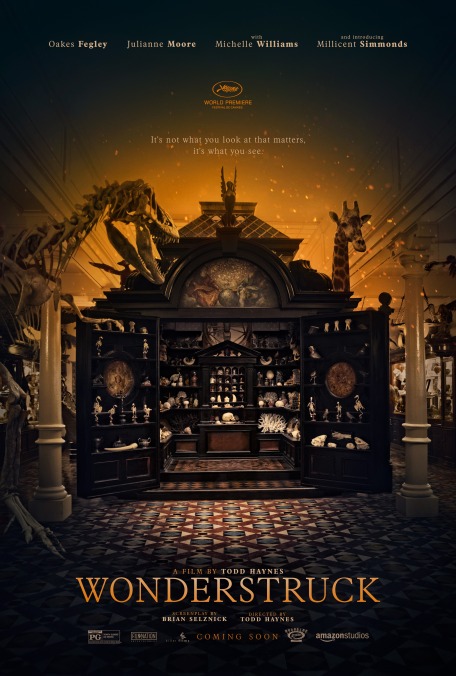Wonderstruck gorgeously mismatches Todd Haynes to the author behind Hugo

For someone who started his career basically playing with Barbie dolls, Todd Haynes has never strayed far from what you might call adult preoccupations: desire, identity, sex, addiction, all that good stuff for the over-18 crowd. On paper, that makes Wonderstruck a radical departure. Like Martin Scorsese before him, Haynes has reinvented himself, however temporarily, as an all-ages entertainer, transforming an illustrated YA novel by Brian Selznick (The Invention Of Hugo Cabret) into a film about the inherent loneliness and, yes, wonder of childhood, filtered through a nostalgic affection for silent cinema. Yet the cult daydreamer behind Safe, Far From Heaven, and other strictly grownup visions hasn’t lost himself to demographic appeasement. Through and through, in defiance of genre, and ultimately to a fault, he’s made a Todd Haynes movie.
Working from a script by Selznick himself, Haynes tracks two stories in parallel, cross-cutting intuitively between them. In 1977, grade-school-aged Ben (Oakes Fegley from Pete’s Dragon) suffers two enormous losses: first of his mother (Michelle Williams) to a car accident, and then of his hearing to a freak lightning strike. Hopping a bus from Minnesota to New York City, the boy goes looking for the father he’s never known. In the same bustling metropolis 50 years earlier, deaf runaway Rose (newcomer Millicent Simmonds, who’s actually deaf, and as expressive as a miniature pre-talkies starlet) searches for screen idol Lillian Mayhew (Julianne Moore)—scenes that Haynes stages like an ersatz silent film, in eye-catching black-and-white and without intertitles. The two kids’ paths will eventually overlap at the Museum Of Natural History, where the deeper connection between them reveals itself.
Haynes’ last movie, the rapturously romantic Carol, treated audiences to the gorgeous phantom of 1950s Manhattan. Working with much of the same team that brought that setting to life, Haynes here offers two bygone, meticulously recreated New Yorks for the price of one, then hopscotches gracefully between them. Rose and Ben’s respective impairments (she can’t hear at all; everything is a muffled hum for him) provides license to indulge in some pure visual storytelling, as during the blissfully wordless passage that entwines the kids’ separate frolics through the museum. Much of the film unfolds as a cross-century duet, leaping back and forth through the years, to the tune of another unforgettably aching Carter Burwell score and through the lens of fellow Carol alum Edward Lachman, who knows how to capture the grit and grandeur of the city that never sleeps. Judged just on craftsmanship, Wonderstruck earns its title.
And yet, for all of the time-warp elegance, it’s hard to shake the feeling that Haynes has authored more of an exercise than a movie: a lovingly assembled flashback pastiche whose emotional core remains oddly theoretical. “Academic” is a word often hurled by the director’s harshest critics, who accuse him of sculpting intelligent but remote fetish objects out of the stuff he loves, from classic rock to classic tearjerkers. What usually saves his films from that charge are the performances, from the quiet tempest of feeling Moore conjures at the center of Far From Heaven’s Douglas Sirk facsimile to the distaff-Dylan swagger Cate Blanchett brings to her scenes in I’m Not There. Devoid of any such anchoring presence, Wonderstruck is sometimes as purely decorative as The Artist in its vague approximation of silent-era grammar. Haynes seems, certainly, to be more in love with his structure—the opportunity to skip from an expensive flapper-era New York to an ostentatiously “funky” 1970s New Yawk—than with his preadolescent characters or poky narrative.
At the heart of Selznick’s story is a kind of ode to museums and their curators, keeping history alive by artfully arranging it. That would seem to suggest a perfect match of director to material. After all, isn’t Haynes a kind of curator himself, propping up his own obsessions into glorious, moving dioramas and carefully organizing the contributions of his ace collaborators? But Scorsese was a better fit, it’s now clear, for Selznick’s brainy but sentimental kid lit; his Hugo robustly energized the author’s storytelling through virtuosic filmmaking, to say nothing of how Marty’s deep wellsprings of film-geek enthusiasm amplified the novel’s. Haynes’ is a chiller, more professorial cinephilia—no less valuable, when applied to his ecstatic melodramas or camp experiments, but perhaps somewhat incompatible with misadventures aimed squarely at early readers, watchers, and prospective curators.
Which raises the question: How will Wonderstruck play with the actual children in the audience? It is, at last, a little sluggish, taking its time getting its two era-divided heroes to the big city, then stranding Ben in a budding friendship of miscommunication and contrived conflict. By the wannabe-weepie climax—when Haynes unleashes the pent-up exposition he withheld during the film’s observational stretches, pulling all the dangling plot strands together—any shot at Spielbergian (or maybe just Selznickian) catharsis has passed. Wonderstruck is too singular to dismiss, especially when compared to the lion’s share of anonymous family fare; every frame bears Haynes’ fingerprints. Now, actually reaching out and touching the thing yourself is another matter. Its magic is encased in glass, to be gawked at and admired from a safe distance.